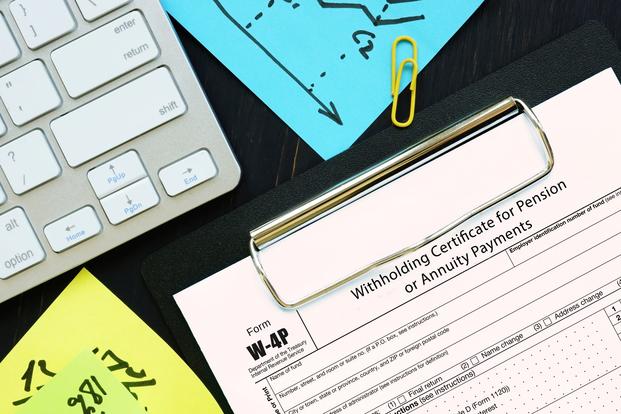Changes to federal withholding tables mean that Survivor Benefit Plan annuitants -- in other words, those receiving benefit payments -- should check their annuitant account statements to see whether their federal income tax withholding is at the right amount.
The military's Survivor Benefit Plan (SBP) provides monthly income to eligible spouses and children after the death of an active-duty, National Guard or reserve member who dies in an eligible status; or a retiree who elected SBP coverage. SBP benefits are subject to federal income taxes.
Therefore, the Defense Finance and Accounting Service (DFAS) allows SBP annuitants to have federal income taxes withheld from their SBP benefits. Because SBP annuities may or may not be all of an annuitant's income, every annuitant will pay a different amount of taxes on their SBP annuity. So, every annuitant has a different amount of money withheld from their annuity.
SBP annuitants give their withholding instructions using IRS Form W-4P, Withholding Certificate for Periodic Pension or Annuity Payments. The W-4P is similar to the W-4 that you fill out to have income taxes withheld from other sources of income. In addition to physically filling out the form, DFAS myPay users also have the option of submitting withholding instructions through myPay.
However DFAS receives withholding instructions, the instructions are applied using withholding tables provided by the IRS. These tables tell payment payers, including DFAS, how much money to withhold based on the information provided by the taxpayer on their W-4.
Because tax laws change from year to year, the IRS updates those withholding tables regularly. A major update became effective for 2023, and DFAS has implemented those changes. As a result, annuitants are reporting that their SBP benefits are having taxes withheld at a higher rate than they did in 2022. This results in a smaller net benefit showing up in their direct deposit.
Now, for some annuitants, this new withholding rate might be exactly what they need to have the right amount of taxes withheld. Having the right amount of taxes withheld over the year means that you get closer to not owing or receiving a refund when you file your federal income tax return the following year. That's a good thing!
However, for other annuitants, these changes may mean that too much money is being withheld from their SBP benefits. In this case, they would receive a larger tax refund when they file their federal income tax return. However, they have the option to adjust their withholding. This can be done using the W-4P form and sending it to DFAS, or making the change in myPay.
Should SBP annuitants change their withholding? Every situation is different. If the annuitant does not typically owe taxes, and nothing has changed in their tax picture, perhaps they want to adjust the withholding to be closer to what was withheld in the past. However, if they typically owe at tax time, or there have been any changes to their overall income tax situation, then they probably want to keep the higher withholding, or meet with a tax professional to figure out the right withholding for their unique situation.
Under our tax system, excess withholding is refunded when the income tax return is filed. So this extra money, if not needed for taxes, will come back to the annuitant eventually. But if it isn't needed for taxes, it might be better to have it back in that monthly payment. Adjusting withholding, if appropriate, is a good way to do that.
Keep Up With Military Pay Updates
Military pay benefits are constantly changing. Make sure you're up-to-date with everything you've earned. Subscribe to Military.com to receive updates on all of your military pay and benefits, delivered directly to your inbox.




